All about tulips: description, types and cultivation

Tulips are one of the most common flowers in a flower bed, which delight with their beauty from early spring. Thanks to the great work of breeders, today you can find several hundred hybrids that differ in the shape of the bud, color, and doubleness of the petals. Tulips are grown in flower beds and commercially by March 8, and in both cases, they require adherence to planting and maintenance rules.

Peculiarities
Tulips are a large family of over 100 plant species that includes about 3000 varieties. Flowers vary greatly in size and shape depending on the cultivar. Although they are perennials, some gardeners prefer to grow tulips, especially hybrid varieties like annuals, as the flowering is not always beautiful in the second year. In some varieties, the buds are cup-shaped, while others are made in the form of a star. Regardless of the type and variety, the flowers have six petals, which can be smooth, fringed or double. Flowers can be single or double, monochromatic, striped or marginal.
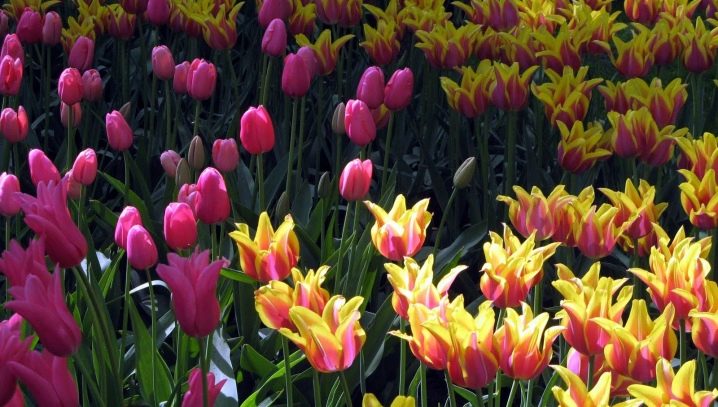
The height of the bushes of the plant ranges in height from 10 to 60 cm. Their leaves are usually of a medium green shade of sharp or oval shape. Foliage can sometimes vary in hue from a deep dark green to bright or light. Leaves can be long or short, depending on the variety, and at least 5 cm wide. Edges can be straight or wavy. The structure is very simple, the origin comes from the stem.

Tulips bloom during the day but close in the evening. These plants are phototropic, which means they lean towards light. The varieties are grouped according to the flowering period. Some bloom early, and when planting in greenhouses by March, you can already collect bouquets, others from mid-spring, but there are also late varieties - late April and May.
Tulips come in almost any shade other than blue, and can grow in almost any natural area. Many variegated species, such as Greigii, have stripes or blotches of contrasting shades on the petals. There are varieties of tulips with a green spot at the bottom of each petal. Gardeners tend to choose tulips for hue rather than color. Many people prefer pastel colors, others choose bright and bold ones. Most tulips are not particularly brightly scented, but some, like Couleur Cardinal, smell quite strong.
Most often these are early maturing varieties, there are those that bloom in the middle of the season, for example, "Glory to Holland", a flower with large reddish-orange Silverstream flowers.
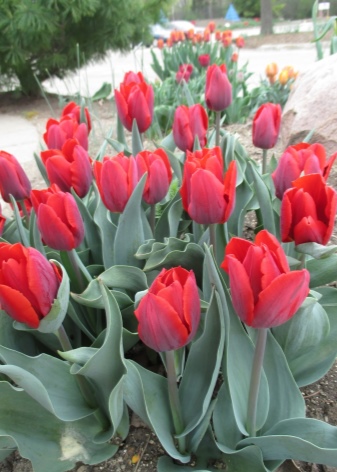

Tulips grow from tubers, each of which produces one flower. The roots grow from the bottom of the bulb called the basal plate. Lateral buds form just above the basal plate. The structure of the plant is very simple. All tulips have a perianth of 6 petals and 6 sepals. Sepals are small leaf-like structures that once protected the flower bud. Tulips have both male and female parts. Each flower contains 6 male reproductive organs called stamens. They consist of a filament topped with a pollen sac called the anther. Each flower also contains a three-lobed female part called a pistil.

It's hard to disagree with the fact that tulips are one of the first signs of spring. These colorful bulbous flowers are loved by gardeners not only for their beauty, but also for their ease of care. The bulbs are tear-shaped, with a pointed tip at one end and a much wider, rounded edge at the opposite. Depending on the variety, the difference in thickness can be very obvious or even flattened. The bulb is covered with a thin layer of rough skin that peels off easily. The balls are planted in the ground with the pointed side up, dipping 15 cm into the ground. The larger the bulb, the larger the tulip will be, which is especially true when it comes to flower size.

Varieties
Before talking about the varieties of tulips, it is worth paying attention to the classification that was adopted back in 1969. It has 15 species, which are divided by flowering time into 4 classes. Green-flowered and fringed were included in this list later than others, only in the late 1980s. The four mentioned classes are as follows:
- earliest flowering;
- medium flowering;
- late blooming;
- botanical.



Early flowering are of two types:
- simple;
- terry.

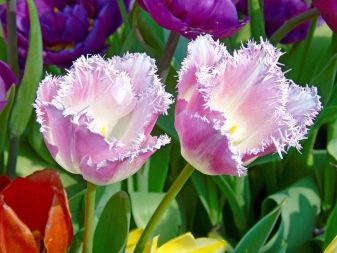
Tulips blooming in mid-spring are divided into the following varieties:
- triumph;
- Darwin's hybrids.


Those tulips that show the latest flowering, that is, by the beginning of May, can be divided into the following types:
- simple;
- fringed;
- lily-colored;
- Rembrandt;
- parrot;
- green-colored;
- terry.

Botanicals include such wild-growing varieties as:
- Foster;
- Kaufman;
- Greig.



Early simple
Early simple hybrids include those varieties that exhibit small cupped or goblet-shaped flowers. The maximum height of the bush can reach 400 mm. The species is distinguished by a strong peduncle, which makes the plant more resistant in bad rainy or windy weather. There are several of the most attractive varieties.
- "Princess Irene" attracts breeders with a two-tone color. It is based on a dark orange shade, the back of the petals is lilac with a purple tint. The flower is goblet, its length is 90 mm. This variety can grow up to 500 mm, there is a bluish bloom on the foliage.

- "White Prince" is part of a new series developed by modern Dutch breeders. The flowers have a snow-white color, the length of the bud is 100 mm. In the sun, slightly pointed petals open completely. In this series, there are tulips in mauve, purple, golden and creamy pink shades.

Early terry
Among the early varieties, there are also terry representatives. Among the features of plants of this class, one can distinguish lush flowering. The flowers retain their decorative appeal for a long time after cutting. The height of the bushes reaches up to 350 mm, the peduncles are not as strong as in the previously described version, therefore, after the rain, the buds can tend to the ground. Among the famous varieties, several are worth highlighting.
- "Monte Carlo" blooms by mid-spring. The flowers reach 120 mm in diameter, the shade of the petals is yellow, the back is greenish. The plant is great for group planting. The foliage is dark with wavy edges.
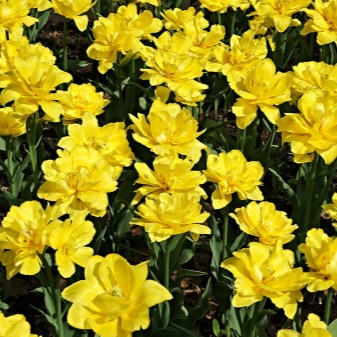

- "Foxtrot". This species shows beautiful double buds, which are 90 mm high. The shade is delicate, creamy pink. There are reddish thin stripes along the edge, which gradually merge with the main tone. Flowering begins in May.
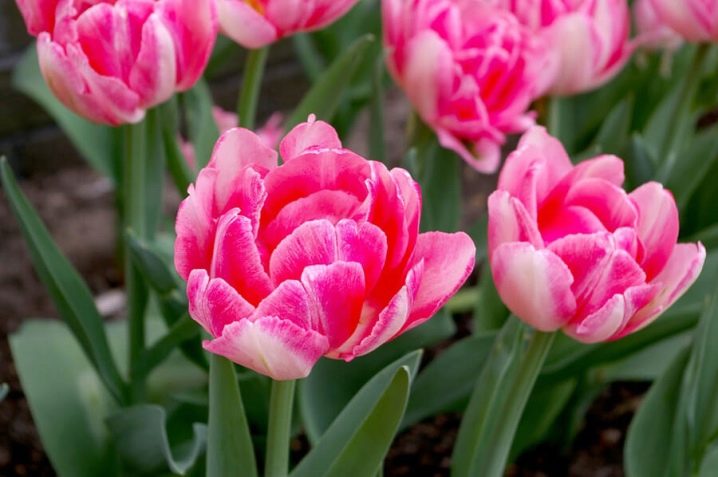
Triumph
This class of tulips is loved by breeders for the variety of juicy colors. All varieties are unpretentious, differ in endurance and can develop normally even in shaded areas. April and May are flowering times. Flowers are used both for bouquets and flower beds. It is worth considering the description of several of the most prominent representatives.
- "Zurel". This tulip cannot but delight with its dark burgundy hue.The bud fully opens only by the end of April. The plant is distinguished by its special grace and goblet flowers.

- Ile de France included in the list of the best varieties of the red shade. Flowers are about 80 mm. The petals have a black bottom, there is a golden border. The length of the peduncles is up to 400 mm.


- Cheers. A new variety of tulip used for bouquets. The leaves are grayish-gray, long. Abundant flowering begins in mid-May. These tulips retain their attractiveness for a long time after cutting and are excellently transported. The shade of the petals is creamy yellow.

- Snow Lady. White flower without additional color inclusions. Plant height - up to 600 mm.

- "Purple is equal" has a very beautiful lilac uniform color of the bud. The flower has a thin graceful shape, blooms in the middle of spring.

- "Laptop". A dark lilac tulip with a narrow bud, which is 70 mm long. Looks perfect in a bouquet, therefore it is popular with florists.

- Royal Virgin. A representative of plants with a snow-white color. The flowers are short, neat, without any additional bright accents.

Darwin's
This hybrid species can be distinguished for its large goblet flowers that stand on strong, long peduncles. These tulips differ in their flowering time, as they delight with their beauty in late April and early May. It is worth considering the most prominent representatives.
- "Big Chief" blooms late in early summer. The bush is formed quite tall. The petals can be cream or slightly pink, the back is always red-crimson. At the peak of flowering, the buds open strongly.
- "Oxford" - This is one of those varieties that gardeners most often associate with May. After blooming, the flowers fall off only after 10 days. The petals are purple, have a velvety surface. The height of the shoots is up to 700 mm, the peduncles are strong.
- "Candy Apple Delight" - This is a beautiful variety with a raspberry color and milky edging of petals. The goblet flowers reach 60 mm in diameter.



Late simple
These are Darwinian tulips, but not hybrid forms. They begin to bloom after the early species. The color depends on the variety; in general, the plants are resistant to wind and rain, and bloom actively in early summer. Several of the most attractive varieties are worth highlighting.
- Long Lady Is a tulip that boasts a graceful flower shape. The flowering period is two weeks. The predominant shade is orange-pink, the crimson back becomes golden towards the edge, but the transition is smooth.
- "Perestroika" Is a new plant with goblet buds up to 120 mm in height. At the beginning, the color of the petals is orange, as the flower opens, it changes to salmon. Flowers do not open widely, while they can retain their attractiveness for up to two weeks.


Lily-colored
From the name it is easy to understand what shape the buds of tulips belonging to this class have. Flowering can be observed throughout May. Mostly flowers of this type are grown for bouquets, but they look good on flower beds as well. It is worth considering the brightest varieties.
- Red Shine. Purple glossy petals bark with a dark red back. This contrast makes the buds stand out from the rest of the tulips. The plant blooms for two weeks, the buds are formed high, up to 90 mm.
- Holland Chick Is a Dutch representative with rounded petals. The front side is pink-cream, the back is white. When the bud opens, it becomes brighter. The height of the flower is up to 120 mm, while the stem is up to 700 mm.


Fringed
This is one of the most sought after classes as tulips captivate with their amazing combination of shades. The maximum plant height reaches 600 mm. The flowering period is in May. As a rule, varieties of this class are used to decorate flower beds. Of the most popular varieties, several are worth highlighting.
- Cummins. It is impossible not to note this tulip for its unusual color. The main shade on the petals is lilac, but it is diluted with moire stains. There is a white fringe along the edge of the petals. During flowering, the color may change and become more saturated.
- "Black Jewel" - This is one of the most spectacular, exotic varieties. The color is dark, something between burgundy and chocolate colors. The buds are formed large, can reach a length of 90 mm.
- "Fabio". The height of the bud of the described tulip is 110 mm. The color is deep red, the fringe is orange, very neat.



Greens
These tulips are distinguished by the variety of bud shapes presented. At the base of the green background on the petals, as a rule, stripes or feathers are located on the back of the petals. Varieties bloom throughout March, buds can grow in length from 300 to 500 mm. The peduncle is strong, in bouquets the flowers do not crumble for a long time. It is worth highlighting a few of the many varieties.
- "Artist". The back of this flower contrasts perfectly with the orange-pink petals. The flowers are lush, wide, the foliage is narrow with a bluish bloom.
- Violet Bird. The petals are dominated by a rich pure purple hue. The back is decorated in a bright green palette. The petals are semicircular, slightly curved outward.


Parrot
These varieties are today the main competitors of the fringed species. The flower is large, cupped. At the petals, the edges go in a light wave, carved. The period of active flowering falls in mid-May. These are quite tall grades, reaching 600 mm, which look good in groups. Several representatives of this class can be distinguished.
- Blue Parrot. This variety appeared one of the first, since then it has not changed at all and has retained its lilac shade of buds. After opening, the flowers reach 180 mm in diameter. Even with an active sun, the brightness of the petals does not decrease.
- "Green Wave" Is a pink flower with green inclusions. It is distinguished by a corrugated edge of the petals and a green back at the bud. Duration of flowering is 3 weeks.


Rembrandt
When they talk about representatives of this class, they always mean the wrong color. Irregular stripes, feathers of a contrasting color - all this is a vivid evidence that the variety belongs to this type. Few know from novice gardeners that such changes were the consequences of the impact of the virus, but breeders managed to consolidate them. Despite the decorative advantages of the varieties, Rembrandt is not in great demand, since the stems are weak and often require support for them. It is worth considering a few prominent representatives of this class.
- Cordell Hull. If we talk about the shape of the flower, then in appearance it most likely resembles a cup-shaped one. The main shade is white, there are pink strokes on the petals. Bushes are large, wide with green leaves.

- Insulinde. The creamy shade of this satin tulip has won many hearts. The second color is violet, which is present in strokes along the petals.

Late terry
These tulip varieties bloom at the end of May and delight with their beauty for about three weeks. From the outside, the flowers look voluminous due to the lush buds, often their breeders are called peony-shaped, but in fact this is a slightly different species. Of the shortcomings, a weak peduncle can be distinguished, which sags after rain due to a large accumulation of moisture between the petals. Several prominent representatives of the species should be considered.
- Ice Cream. From the side, the bud of this tulip is very similar to ice cream, hence the name. The perianths are crimson green and the petals are creamy white. The plant is not large, the maximum is 450 mm in length, while the bud height is 120 mm.
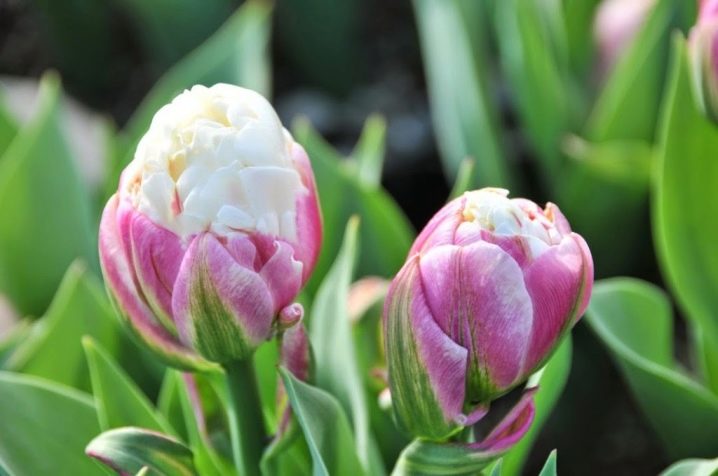
- "Up White". An amazing snow-white shade and petals, as if made of satin - that's what draws attention to this tulip.When the goblet flower blooms, it reaches 120 mm in width.

- "Uncle Tom" - this is a representative of the dark palette, which has burgundy-chocolate petals. This densely doubled flower reaches a width of 80 mm.

Botanical
Cultivars classified as this species have preserved the characteristics of wild tulips. The minimum height of the bush is 100 mm, and the maximum height is 500 mm. There are forms on the list that delight with their flowering in early spring, and there are later ones. Most varieties have a sweet, pleasant aroma. It is worth considering several varieties most often found in the flower bed.
- "Shrenka" Is a fragrant, beautiful tulip that can please with different colors. There are white, several shades of red, yellow and purple flowers.
- "Baker"... This variety is often called rocky, it can withstand short frosts, and is only 200 mm high. There are many hybrids that differ in shade.


- Kaufman. This is one of the earliest tulip species. One of the main distinguishing features of the varieties is the small size of the bushes, rarely more than 200 mm in height. The flowers are lily-shaped, when they open, the flower resembles a star. Can be used to decorate an alpine slide. Among the popular varieties, it is worth highlighting "Hearts Delight", which shows large buds on a short stem. Outside, the petals are bright pink, inside are cream. Blooms in early April, there are burgundy stripes on the foliage.

- Foster... These tulips have powerful stems. They reach a height of 500 mm. Active flowering time falls in mid-spring. Of the distinctive features are wide foliage with a bluish tint, on the surface of which there may be burgundy spots or stripes. Of the varieties stands out "Purissima Design" - these are white flowers, on the petals of which there are stripes of lemon shade. The peduncle is high; you can buy hybrids of red, orange, golden or crimson shades.

- Greig... These are plants that open their buds in mid-spring. The height of the bushes reaches 350 mm. Among them, tulips of a red palette are most often found, the buds at the base are wider than in other classes, and the petals are slightly bent. The foliage is large, dotted with stripes of red or brown. Most often, you can find the Pinocchio variety in the flowerbed, which has become popular due to its large and very bright buds. The crimson color with a wide stripe along the edge of an ivory shade distinguishes the tulip from others.

Peony
These are early tulips, which are distinguished by a densely doubled shape. The petals are silky and large. Of the varieties demanded by plant breeders, several can be noted.
- Brownie - This is a plant with a rare color, similar to the flame of fire. The buds are voluminous, an orange-yellow hue spreads along the edge and towards the middle, the middle is bright red.
- Esprit - This is a peony flower of an unusual shape, the petals of which are pink-orange. Along the edge, the entire composition is decorated with a golden fringe. The diameter of the bud at full opening reaches 150 mm.


Multi-flowered
Plants from different classes were combined into this group. Their main distinguishing feature is the ability to create fused stems. One bush can give a luxurious bouquet incomparable with anything, while the shape and color of the buds may differ. Of the famous representatives, "Belicia" stands out. It is a double, early flower with white petals that perfectly complement crimson strokes or borders. Up to 6 buds are formed on the peduncle. Flowering time is mid-spring.

Dutch novelties
New varieties of tulips are imported from Holland to our country every year. Consider several among the latest popular varieties.
- Angola Is a purple-colored variety from the Triumph class. The glass of the bud is slightly oblong, blooms for a long time, starting in May.
- Verandi. This favorite of professional florists has a 100 mm glass bud. The color is deep red, with a border on the petals of a yellow-orange hue.


When is the best time to plant?
The planting time of tulip bulbs in the garden depends on the climate. In most regions of our country, planting is carried out from September to early October. The grower will need to check that the soil has a temperature of at least + 16 ° C. If planting is carried out in a greenhouse for bouquets, then it can be done in February.... Tulips are usually planted in September and October in hardiness zones 4 and 5, in October or November in zones 6 and 7, in November and early December at 8 and 9, and at the end of January in zone 10.

Important! In warm climates, the tulip bulbs will need to be refrigerated for 6 weeks before planting. A paper bag can be used as a container.
Planting and care in the open field
When it comes to choosing a soil, it is worth making sure that it is suitable for the plant. Tulips prefer sandy, neutral or slightly acidic soil that is well drained. It is allowed to enrich it with compost or humus. You should not plant flowers in places where water stands for a long time, because in such conditions the bulbs quickly rot. Plants need plenty of sunlight throughout the day, so an open area with no trees or shrubs nearby should be the ideal planting site.

Before planting, the bulbs are treated with a manganese solution to protect them from fungal infection. The planting material is kept in the solution for about 2 hours. The depth of placement of the bulbs should be equal to three times the volume of the bulb. If they are immersed too shallowly in the soil, the tubers will freeze when frost sets in. When planted deeply, the variety begins to degenerate, the buds become much smaller.
Important! When expensive and rare varieties are planted, florists try not to take risks and immerse the tubers in the soil in spring, when the soil has warmed up enough and frost is not expected.
A distance of at least 200 mm is observed between the beds, it can be reduced to 100 mm between the bulbs, but it is always better to focus on the dimensions of the planting material - the larger the tuber, the greater the distance. It is best to fertilize the soil before planting. Particular attention will need to be paid to watering. Enough once a week so that the tubers do not rot. If it rains often, then watering may not be carried out at all. In hot regions with high air temperatures, it is good to lay mulch on the soil in spring, it is it that helps to retain moisture in the ground.

Fertilizer is applied a second time after the first leaves appear. The type of top dressing depends on what the soil was fertilized with in the fall, the second time the same fertilizer is not added to the soil. Urea and ammonium nitrate are best. The second time you need to feed the tulips when the first buds appear. Plants planted in the ground since spring are best supported with mullein or sludge. If the climate is arid, then you will need to additionally feed the soil with zinc and boron.
The flowers are cut when the bud has already formed and acquired the required shade, but has not yet blossomed. There must be at least 2 leaves on the stem. To disinfect a cut of a plant, it is treated with a soda solution or manganese. You can get high quality planting material if you dig up the tubers every year. It is equally important to know when and how to do it. The first sign of the beginning of work is yellow leaves, a dark brown tint on the bulbs.
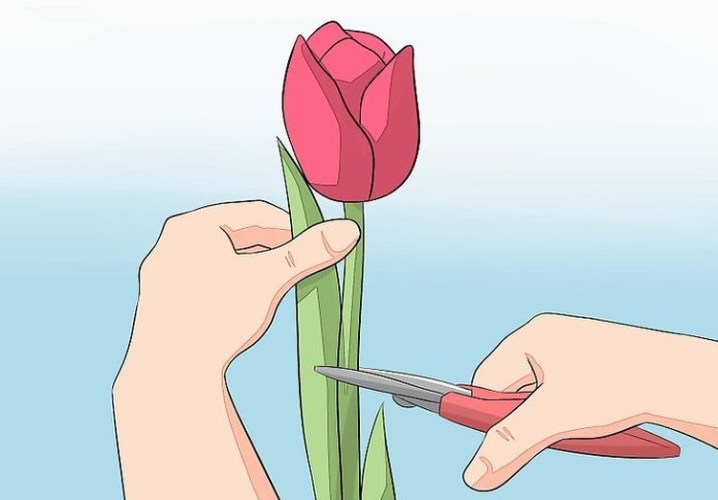
The subtleties of growing at home
As strange as it sounds, you can easily grow a tulip in a vase on the windowsill. Although the plant does much better outdoors, in a simple pot or even in a container of water, it can also delight with abundant flowering. The professionals call this distillation. For distillation, planting material is placed in the ground in the fall, so that the flower has already blossomed in early spring. For normal growth, the plant will need to provide a favorable place where there is enough sun, there is no draft, and the air temperature remains at a comfortable level.

Cooler temperatures and good indoor humidity help prolong flowering. You can use a spray bottle to spray water, but you cannot let the drops fall on the foliage. When grown in soil, the tulip will need to be placed in well-drained soil with perlite and watered frequently, but not flooded. For irrigation, simple tap water is suitable, only settled for several days. You do not need to use boiled one.

The water temperature should be around + 20 ° C or a few degrees warmer than the room temperature. As a top dressing, it is allowed to use water-soluble fertilizers in a small amount. It is worth bringing them in with watering. Do not expect a plant to bloom in a pot every year, in this case it is an annual. The bulb will acquire a second life if it is moved to open ground next fall.
Diseases and pests
Tulips are susceptible to aphids. This insect has a tiny pink or green body and proboscis, with which it sucks liquid from foliage. The negative impact of pests leads to discoloration and early leaf fall in case of severe damage. Aphids secrete a sweet, sticky substance called honeydew. Areas covered with honeydew often become infected with black fungus or mildew. Fortunately, a gardener can easily get rid of the pest using neem oil or an insecticidal soap solution.

Tulips are susceptible to destructive diseases such as root rot. This disease invades the roots and can spread to other parts of the plant. If nothing is done, rot will kill the bulb. Mycelial rot is a problem that affects every part of the tulip. It looks like discolored, scorched spots on leaves and petals. The stems become weak and break, the bulbs become covered with ulcers. Gray mold causes the tubers to simply dry out and not produce new growth. The easiest way is to carry out high-quality prevention. To do this, you will need to monitor the moisture content of the soil and, when planting, treat the tubers with a fungicide.


Early symptoms of fungal diseases include discolored, wilted leaves, and sporadic spots on the plant, including flowers. Often, the plant breeder has to deal with nematodes - the defeat of the bulbs with brown spongy spots. The problem is solved by treatment with the same fungicide at the planting stage. It is worth saying that slugs and caterpillars are carriers of some bacterial and fungal diseases, so they also need to be fought with. The best remedy is to scatter ash around the plantings; in due time it will play the role of additional fertilizer.
Reproduction
Tulips produce seeds through sexual reproduction when their flowers are pollinated by wind or insects. Sexual reproduction combines the genetic material of two plants. Tulips contain both male and female parts, which allows them to reproduce asexually. In asexual reproduction, the roots or bulbs are split into several lobes, each ready to produce a new flower. Tulips require a cool temperature, which signals the start of the reproductive cycle in accordance with the biological clock. The bulb is planted in the ground several weeks before frost.

Roots sprout first, followed by stems that grow to the surface of the soil. After that, growth stops and the plant remains dormant during the winter.As soon as the soil warms up in spring, the tulip continues to move upward, the stem breaks through the ground, leaves appear, followed by a bud. The tulip bulb is a kind of plant embryo, packed in several layers of dense tissue. For quality flowers, it is best to renew the bulbs every year.
The best planting material is the one that was grown independently.

Storing the bulbs
Early tulips are harvested first. The tubers are dried, cleaned of soil and removed to a dark place, for example, in a basement or closet. So that the planting material does not deteriorate, it must be properly stored. Indoor temperature should be no more than + 25 ° С, but also not less than + 22 ° С. Gradually, it will need to be reduced to + 18 ° С, and then + 12 ° С. The storage must be dry. The maximum percentage of humidity is 70%.

Use in landscape design
With a good imagination, you can create a variety of compositions in the garden using not only tulips, but also other flowers. Multi-colored compositions allow you to decorate the yard for the entire summer period. If you correctly calculate the flowering period of various varieties, the flower bed will remain bright from early spring to mid-summer. Each bulb produces only 1 flower, therefore, to create flower arrangements, it is advised to grow them in clusters of 5 to 10 pieces, each at a distance of 30 cm from each other.

Experienced landscape designers advise avoiding planting bulbs in straight rows when using a small number of bulbs, as this will look unnatural in the flowerbed at intervals. Large-scale tulip plantings can be made with bulbs spaced 20 cm apart, or in addition to spring annuals such as pansies. The same rules apply in containers. Clusters of tulips appear more dramatic and visually prettier when they are made up of more bulbs.
Layering in containers allows for flowering continuity over a slightly longer period in the spring.

Depending on the type of tulip, the height of the peduncle must be taken into account when determining the number of bushes used in the design. Tall flowers look best when used in large quantities in close proximity to other plants of similar height... These garden plants are available in any color other than blue. Many varieties have two colors on the petals in the form of spots, specks or stripes. The choice of color depends solely on the personal preference of the grower.

Warm tones include red, orange, or yellow. They can be presented in combination with each other. These colors stimulate the imagination and lift the spirits. Cool tulips such as pink, lavender, white, purple, black or pale green can help create a peaceful atmosphere in the garden. They can be mixed when decorating a flower bed with any variety of a suitable shade.

White petals are a versatile option. It will be the perfect complement to any other flower, even if it is not a tulip. With the help of such plants, you can create contrasting compositions, dilute too saturated, poisonous shades. White is meant to soften red or orange.
Finally, the all-white tulip collection is often considered one of the most elegant and sophisticated.

In addition to wonderful buds, the described flower can boast of a variety of color palette of leaves. There are dark green, gray-gray, bright green leaves, which become an ornament or a common background for other plants, even when the buds have not yet blossomed. Some landscape designers believe that a flower bed planted with only tulips looks dull until the first leaves finally appear on the surface in the spring. Up to this point, garden designers usually plant carpet with complementary colors that help bridge this gap. Pansies and violas are a favorite backdrop for tulips.

They will contrast beautifully with the flower during flowering. The companion plant is designed to emphasize the brightness of the shade of the buds, sometimes to enhance the composition.
Important! Plants such as ornamental cabbage, snapdragon, forget-me-not, as well as other later spring flowers, such as daffodil or hyacinth, can be a great addition.

How to plant tulips correctly is shown in the video.







































































































The comment was sent successfully.